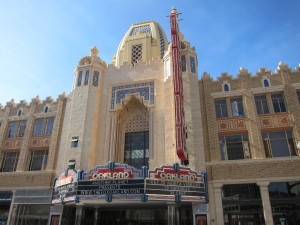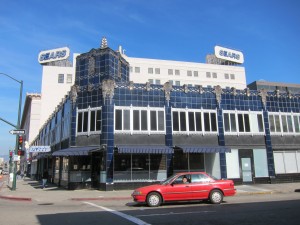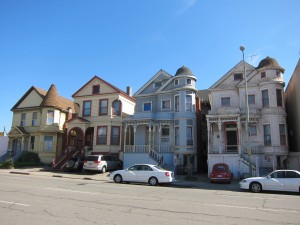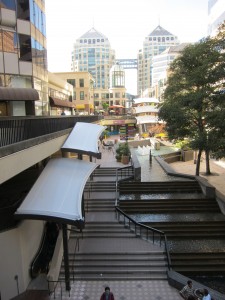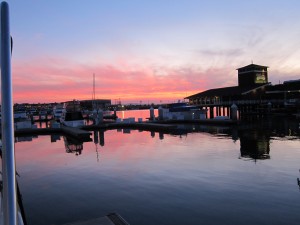We knew that every Sunday morning there was a Farmer’s Market at Jack London Square. But when Sunday morning rolled around, we almost fell over from shock when we walked upstairs shortly after waking up to see this:
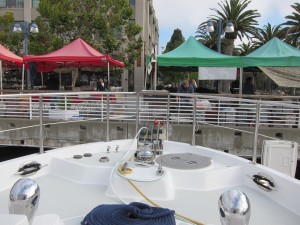 The booths were so close to Kosmos that we could have stood on the bow and stolen produce from the stands! Here is a shot from the other direction:
The booths were so close to Kosmos that we could have stood on the bow and stolen produce from the stands! Here is a shot from the other direction:
 Having the Farmer’s Market come to us made shopping easy! It was an especially good market, too. We knew we’d miss it when we were gone.
Having the Farmer’s Market come to us made shopping easy! It was an especially good market, too. We knew we’d miss it when we were gone.
We did a little exploring of downtown Oakland in the month we had Kosmos there. Oakland was officially made a town in 1852, the same time the shipping industry began on Oakland’s shores. Oakland was prosperous from the beginning. In addition to the shipping wharves, Oakland became the main staging post for passengers and cargo journeying between the Bay Area and the Sierra foothills during the California Gold Rush. In the 1860s a railroad hub was put into Oakland and the town boomed even more, with shipbuilders, automobile manufacturing, canneries and many more industries developing there. Oakland’s history is rich with fascinating information, but we’re not going to get into the details in this post.
As we walked around downtown Oakland, we noticed that most of the buildings looked to be from the late 1800s to early 1900s. It was clear from the architecture, the quality of construction and the appointments that this was once a very wealthy city, and that it was beautiful in its heyday. Here are a couple of examples:
Oakland continued to flourish until World War II. During the war, an influx of poor laborers were brought in to work at the ship yards, and they were recruited mostly from the Deep South. Long standing Oakland residents complained that the new Southern arrivals “tended towards public disorder” and didn’t care for the racist attitude that the Southerners — both the blacks and whites — carried. Racial tensions and segregation followed. Many affluent locals moved out of Oakland.
After the war ended, things got worse. With the disappearance of Oakland’s shipbuilding industry and the decline of its automobile industry, jobs became scarce. The extensive public transit lines were mostly dismantled, replaced with freeways that partitioned off neighborhoods. The police force was now full of white Southerners who persecuted the blacks, and racial tensions became out of control. 100,000 of Oakland’s more affluent community members fled to surrounding towns.
During the 1960s, the Hell’s Angels took over the neighborhood. During the 1970s, drug kingpin Felix Mitchell created the nation’s first large-scale gang-controlled heroin and cocaine dealing operation. Needless to say, crime and murder were a big problem — with rates twice of most major cities.
In the 1990s, the redevelopment projects began. Oakland has been slowly but surely been getting nicer since then. These days, in the downtown area, most of the old buildings have been renovated, though there are still a few dilapidated buildings dotting the neighborhoods. This block of Victorian houses is a perfect example. The middle two are in great shape, the one on the left is in fairly good condition, and the one on the right has been seriously neglected.
The less well kept commercial buildings also tend to house seedy venues like Adult Bookstores. In and amongst the old buildings there are quite a few new, modern buildings, as well, and most are higher end.
There was no denying downtown Oakland has a lot of character. As you walk down any given street, you’ll pass an odd variety of things — for example in a one block stretch near Jack London Square there is an old, kind of scary looking shipping warehouse next door to brand new luxury condo complex, then a dilapidated porn shop, a charming coffee shop that has been around for 50 years, a chic high end restaurant in a gorgeously renovated historic building, a blocky government building with several homeless people sleeping on the steps, and a medical marijuana facility. All on the same block.
For the most part we felt safe, but there were a few small areas, like near the freeways, that were a little scary. We walked around freely during the day, but after dark we tended to use public transit even if we were only going a few blocks.
Another benefit to being here is that we’ve been treated to amazing sunsets most nights, as well:

